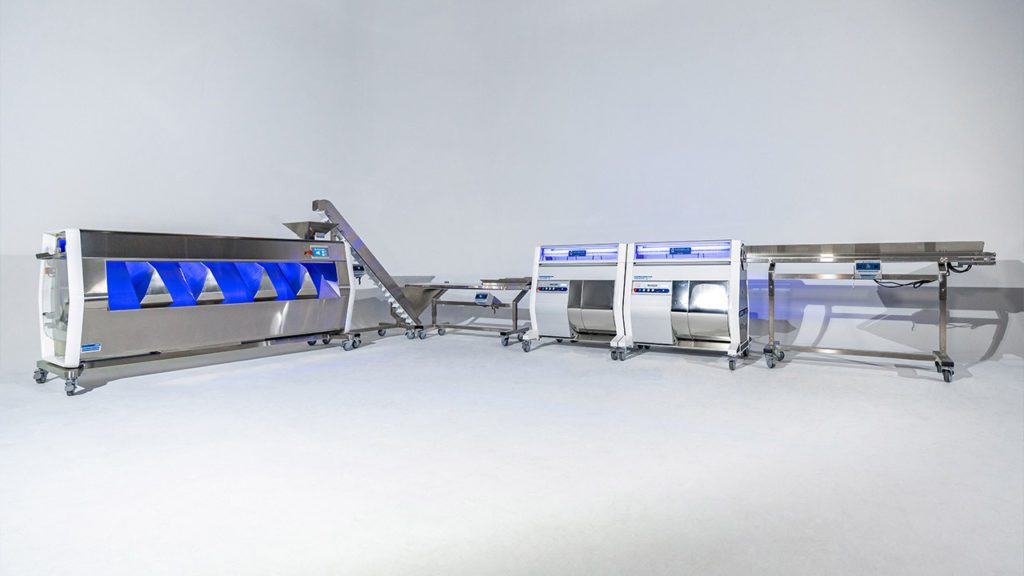There are a number of powerful automation options available to cannabis growers that can assist in the harvesting process, especially for large-scale operations. This brief guide will help you determine whether automation in the harvesting process might benefit your cannabis operation and includes tips for maximizing the potential of such automation capabilities in your own grow facility.
Note that while mechanical trimmers and other harvesting tools might not be a fit for every operator — there is a certain draw to small-batch cannabis farmers offering hand-trimmed flower, after all — the benefits of automation are most appreciated when you are ready to scale your operation. And for the cannabis industry’s larger grow sites, the automation of certain labor-intensive steps is practically essential.
But first, let’s consider:
What are the main advantages of automation?
Automation helps cannabis operators save on time and labor.
Time is money: if you can reduce the time to harvest and produce shelf-ready cannabis flower, you are ultimately reducing the amount of cash that’s tied up in your production, which lets you put that cash toward other areas of the business. Additionally, this gives you the flexibility to offer your finished product at a lower price point, which in turn can increase your market share as a low-cost leader in the space, or simply increase profit margins to help fuel growth in other areas of the business.
Automation lends itself to regulatory compliance and product consistency.
Automating the cannabis harvesting process nets benefits both for the cultivators who must adhere to strict industry regulations and for consumers who expect a consistent and recognizable product. Manufacturing a consistent product that consumers can rely on each and every time they make their purchase is almost impossible to achieve without automating the process with the use of machines in the hands of trained professionals.
Automation helps to reduce the monotonous, post-harvest grind.
Automated trimming machines and the like can also benefit workers — ultimately, these tools can help you retain your workforce by removing busy work and repetition, which in turn can make employees feel even more satisfied with their work.
Logistics — trimming, bucking, milling, and more
The most commonly automated step in the harvesting process is the trimming of cannabis flower. Trimming is one of the key steps in creating shelf-ready flower; however, finding and retaining enough staff to tackle this monotonous and time-consuming process can be a major challenge. For this reason alone, trimming machines are becoming increasingly popular in the cannabis space.
Other steps in the cannabis harvesting process have also been automated. Buckers and shredders are used to strip and break down cannabis/hemp plants ahead of the trimming process and sorters are used to batch trimmed flower by size. From there, the trimmed and sorted flowers can be packaged for sale or move on for further processing. In this case, a cannabis milling machine is used to grind the dried flowers or trimmed leaves in preparation for extraction or in the manufacture of pre-rolls.
Designing the facility
One big benefit of implementing automated harvesting processes is that these devices can generally be retrofitted into any existing cultivation site, so long as the operators are willing to adapt their own processes. That said, if you are building a cultivation site with the full intention of using automated trimmers or even full plant-bucking devices, it helps to pre-determine the types and sizes of these machines and allocate appropriate space in your warehouse, greenhouse, or other processing locations.
Whether your facility is a new build, a retrofit, or an existing cannabis processing operation, don’t underestimate the need to have a well-equipped and adequately-sized maintenance and wash bay. The number one preventative maintenance activity you can perform on any cannabis processing equipment is regular cleaning. Implementing regular and effective cleaning SOPs and following a manufacturer-recommended preventative maintenance program will keep your processing equipment in tip-top shape and help you avoid unnecessary downtime.
Optimize for processability
Every year introduces new strain options for cannabis growers and consumers. When making the choice of which strains to run with for the season, growers consider a number of different factors, including marketability. While marketability is certainly important for driving sales of your products, processability is just as important. Whether you are running an indoor, outdoor, or greenhouse operation, growing strains that are easy and efficient to process will allow you to minimize manufacturing costs and maximize margins. To the degree possible, cultivate strains that produce dense, regularly-shaped flowers and tick the box of being fan favorites and you’ve created a win-win situation!
Conclusion
Ultimately, automation unlocks levels of efficiency that cannot be realized with a manual workforce alone. Whether it’s bringing automation to just one step of your manufacturing process or moving towards full automation, cannabis growers and processors who are willing and able to embrace the industry’s leading automation solutions are positioning themselves to not only survive but to thrive in today’s competitive commercial cannabis market.
Get daily cannabis business news updates. Subscribe
End

